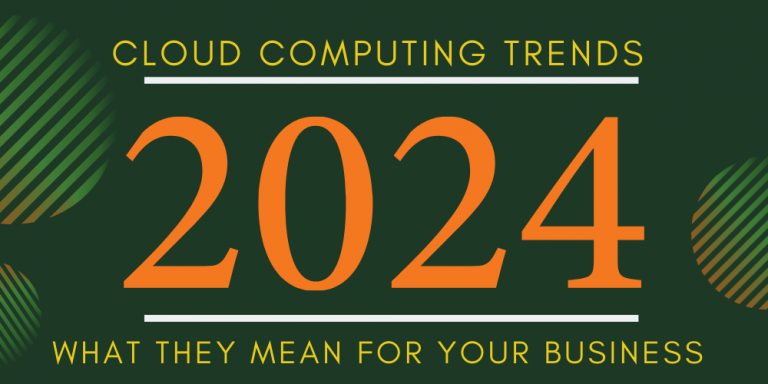
This past year was a big one for cloud computing, and one thing’s for sure: there’s no sign of it slowing down. Quite the opposite!
In 2024, Gartner forecasts that the worldwide end-user spending on public cloud services will grow to $679 billion, following a major year for the cloud in 2023 where many organizations used cloud computing either as a technology disruptor or capability enabler.
But it’s not just this continued incline in adoption and utilization of the cloud that promises big things in the not-so-distant future. On the contrary, Gartner’s forecasts indicate that this is just the start of a major turning point in which cloud computing shifts from a technology disruptor to becoming a necessary component for maintaining business competitiveness. It’s for this reason that cloud spending is projected to exceed $1 trillion in 2027, and complete its transition into a business necessity by 2028.
With that in mind, what cloud computing trends can we expect to see in 2024? How will the cloud continue its growth from a convenient to a critical business tool? And what does this all mean for your cloud and wider business strategy?
Let’s find out.
5 cloud computing trends in 2024
- Edge integration
- Sustainability
- Models as a service
- Multi-Cloud optimization
- Security evolution
Unmissable insights into hiring AWS talent in 2024
Edge integration
Edge computing is a cloud-related paradigm that processes data as close as possible to the place it was collected. In 2024, this looks set to loosen the cloud’s dominance as the sole computing environment, as businesses begin to look beyond centralized data centers in favor of a more diverse resource ecosystem.
That’s because edge computing is a growing trend in itself that will only continue to evolve for the next 12 months and beyond. You only need to look at the adoption of advanced 5G networks and the development of smaller, more powerful, memory-efficient processors and algorithms to see this.
Take, for example, the real-time heart monitor features integrated into today’s smart watches. Rather than the device collecting that data, sending it to a healthcare cloud for analysis, and then back to the monitor, these devices can instead act as the edge servers and analyze the data locally, wasting less time and bandwidth in the process. As devices like these smart watches and phones begin to integrate more machine learning (ML) features in the coming year, we can expect ML models to run smoother and more cohesively on edge devices, with features such as Amazon SageMaker Edge already making waves in this area.
Of course, this isn’t about shifting away from the cloud. Instead, edge computing is more concerned with reducing reliance on the cloud by enabling organizations to capitalize on each data stream’s most cost-effective and efficient option. By unlocking more robust and localized control, we expect to see businesses leverage data more effectively and efficiently, no matter where it resides.
Sustainability
It’s hard to emphasize just how big of a role cloud computing can have in accelerating environmental initiatives. As the issue of global heating becomes more and more pressing with each passing year, we expect sustainability to be a top trend in the cloud space this year.
The numbers don’t lie. According to the latest projections by McKinsley & Co, the cloud has considerable potential to enhance the sustainability transition by reducing the cost and time required to implement various decarbonization initiatives by 2-10%. Moreover, the same study found that these technologies can decrease up to 32 metric gigatons of CO2 equivalent by 2050, which is roughly half of what’s needed to reach net zero by 2050.
While manufacturing and transportation stand to benefit the most from cloud-powered decarbonization solutions, we expect sustainability to take center stage industry-wide this year, with cloud providers continuing to invest heavily in green cloud technologies and advocate for more sustainable practices. And with AWS pledging to achieve net zero by 2040, this focus will not only improve the sustainability of the cloud providers themselves, but will reduce the carbon footprint of their customers, too.
As organizations begin to take much-needed action in aligning their environmental practices with their internal values, customer and stakeholder expectations, and new legal requirements, the environmentally conscious cloud will prove a vital tool not just to socially responsible organizations, but to the planet as a whole.
Models as a service
It will come as little surprise to learn that the aforementioned ML integration isn’t the only time we’ll cover AI and ML in this article. After all, the mainstream emergence and rapid evolution of these solutions in the past couple of years has marked a hugely significant breakthrough in the next generation of technological adoption.
What you might not be as aware of is the massive role the cloud has to play in this adoption.
AI models like the ones powering ChatGPT require a whole lot – and we mean a whole lot – of data and resources, and these aren’t readily accessible to a lot of organizations. So, as businesses begin transitioning from proof-of-concept to production systems, new infrastructure will be required to support this shift.
The cloud therefore looks set to play a major part in democratizing AI by offering models-as-a-service to businesses. Fully managed services like Amazon Bedrock are already proving highly effective in accelerating the adoption of GenAI and ML within organizations by enabling access to the social and economic benefits of these solutions without requiring large-scale infrastructure changes. What’s more, the cloud provides a preferred environment to train data with convenient provisioning and scaling capabilities.
For many businesses in 2024, specialized cloud models-as-a-service will likely prove the easiest and most effective path to GenAI and ML adoption.
Multi-cloud optimization
Across the professional landscape, there’s been an observable shift towards hybrid and multi-cloud use, and we expect to see organizations optimize their adoption of these environments this year.
A one-size-fits-all approach to cloud solutions is becoming increasingly old news, with Forbes predicting that as many as 85% of large organizations will use a multi-cloud strategy this year.
That’s because with an increased demand for data storage, there has been an increase in the price of this too, which has led many IT leaders to reassess their cloud approach in favor of a more tailored and dynamic strategy that combines both public and private clouds, minimizing wasteful use of the cloud and, in turn, saving them money.
Of course, the benefits of a multi-cloud strategy don’t end there. In addition to storage efficiency and cost effectiveness, a hybrid approach offers far greater flexibility when using a variety of tools—for example, using a different cloud that integrates with OpenAI rather than building an LLM in your existing cloud environment from scratch. By identifying the optimal cloud resource for specific workloads and combining with on-premises infrastructure when necessary, organizations have greater freedom in optimizing their strategies by leveraging vendor-agnostic solutions.
That’s not to say it’s all plain sailing. Hybrid-cloud strategies will come with their own hurdles and complexities, so be sure to consider how you will optimize aspects like cloud management and operations, data governance, and integration with legacy systems when using this approach.
Security evolution
With each passing year, the rise in cloud computing adoption and the evolution of cyber-crime capabilities means that cybersecurity risks are being amplified further. And with that comes the need for an evolution in cloud security.
With cloud security taking center stage in 2024, businesses need to recognize that it’s not solely the responsibility of cloud providers to ensure that private data is kept safe, and understand the important role they play in actively engaging in cybersecurity best practices. This includes staying well informed about the latest threats, educating employees on risks and mitigation, and regular vulnerability assessments.
This year, it’s more important than ever for cloud providers, partners, and their customers to be collaborative and promote transparency around security to successfully build trust and effectively foster a secure cloud ecosystem. We predict that this year, a secure cloud ecosystem will be dependent on five key areas:
- Serverless. With the rapid expansion in serverless computing comes a greater need to pay close attention to specialized serverless security tools and practices. Organizations are turning to serverless functions and data in their numbers, but without proper security, these advantages are compromised by ever-changing security threats. So, we expect this area to receive plenty of attention in 2024, leading to the emergence of new solutions and strategies to safeguard against vulnerabilities and breaches in serverless applications.
- Data encryption. Data is one of the most valuable assets at your organization’s disposal, so it makes sense to ensure it’s sufficiently protected at all times. Data encryption safeguards sensitive information stored in the cloud by converting data into an unreadable format, preventing any unauthorized access even if the security to your cloud storage systems is compromised. With hacking techniques only becoming even more sophisticated with the help of AI and other breakthroughs in cyber-crime capabilities, advanced encryption algorithms that protect from cyber-attacks and even quantum computing threats will be in high demand.
- Blockchain. The blockchain has recently begun playing a more pivotal role in cloud security, and this year we expect it to come into its own as a core security component. As a decentralized database, the blockchain is far less susceptible to hacking, as each cloud user has sole control over their data. It also minimizes vulnerability thanks to there being no central points of failure—with data distributed across a network of nodes, it’s very difficult for hackers to access and corrupt data, making it a valuable commodity to cloud security best practice.
- Authentication. In 2024, we expect multi-factor authentication (MFA) to become the new standard, acting as a robust authentication mechanism to control access to cloud resources. Traditional password-based verification is very vulnerable to social engineering and brute-force attacks, so we see cloud security best practice moving away from this method in favor of embracing layered approaches that leverage new evolutions like biometric verification, voice recognition, and user behavior analysis.
- Disaster recovery. Even with all the above security strategies in place, things can still go wrong – especially in instances of mitigating circumstances like natural disasters and hardware malfunction. To minimize disruption to your cloud operations, having a robust disaster recovery plan in place is a non-negotiable for your organization this year. Thoroughly implementing best practices like geographically dispersed cloud infrastructure, automated data replication, and seamless failover systems will prove key in minimizing downtime and data loss to ensure all-important business continuity and data protection.



